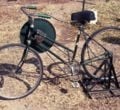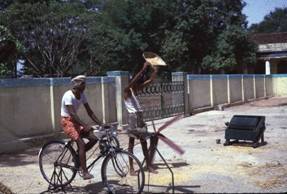
This manual describes the design and construction of a device which, when attached to a standard bicycle, will permit it to be used as a pedal‑power machine. The resulting machine, known as a dual-purpose bicycle, can be used to power numerous small‑scale mechanical devices such as grain threshers, grinders, water pumps, electrical generators, and a variety of small machine tools. When desired, the dual-purpose bicycle can be converted from its transportation mode to its pedal‑power mode, or vice versa within a matter of minutes.
It should be noted that the design criteria, materials used, and the procedures adopted in construction may be modified to suit local situations. It is suggested that low-cost and readily available materials and standard bicycle parts be substituted whenever possible. Changes in construction method and in dimensions should be made according to the availability of materials and manufacturing capability.
Dual purpose bicycle[edit | edit source]
-
Figure 1: Transportation Mode
-
Figure 2: Power Production Mode
Design considerations[edit | edit source]
When designing our attachment, the following considerations were taken into account:
- The device should be suitable for local manufacturing capabilities.
- The attachment should employ low-cost materials and manufacturing methods.
- It should be accessible and affordable by low-income groups, and should fulfill their basic need for mechanical power
- It should be simple to manufacture, operate, maintain and repair.
- It should be as multi‑purpose as possible, providing power for various agricultural implements and for small machines used in rural industry.
- It should employ locally available materials and skills. Standard steel pieces such as steel plates, iron rods, angle iron, and flat stock that are locally available should be used. Standard tools used in machine shop such as hack saw, files, punches, taps & dies; medium duty welder; drill press; small lathe and milling machine should be adequate to fabricate the parts needed for the dual-purpose bicycle.
- It should make use of standard bicycle parts wherever possible.
- The device should adapt easily to as many different bicycles as possible. No permanent structural modification should be made to the bicycle.
- Though the device should be easy to take off the bicycle, it is assumed that it would usually remain attached to facilitate readiness and ease of transport from site to site. The device, therefore, should not interfere with the bicycle's transportation mode.
- The broad stand, which provides stability during power production mode, can be flipped upward during the transport mode. This stand/carrier would be a permanent fixture of the dual-purpose bicycle.
- The power take‑off mechanism should be as efficient as possible, and should develop relatively high r.p.m. (close to 200) for versatility of application. We had seen designs for devices that take power from the rear tire by means of a friction roller pressed against it, but we had doubts about the efficiency of this arrangement. In order to improve efficiency we used hard bearing surfaces such as roller chains, sprockets and ball bearings. We decided that the most appropriate location for this power take-off mechanism would be at the front of the bike near the fork tube (see photographs).
- Care must be exercised to insure that the power take-off assembly is far enough forward so as not to interfere with pedaling. Most standard adult bicycle frames have plenty of room for the power take-off mechanism and pulley. Power is supplied to the shaft by means of a chain from the bike's chainwheel (crank) to a ratcheted sprocket on the shaft. During the prime-mover mode, the bike's regular chain is slipped off of the chain-wheel, and the specially sized chain to the power take-off mechanism is slipped on.
- The device should be able to transmit power to a variety of machines, and changing drive ratios should be as simple as possible. We decided that a V-belt and pulley arrangement would be most appropriate for this. Belts do not require the precise alignment that chains do. Belts can even accommodate pulleys that are slightly skewed with respect to each other. Changing drive ratios is as easy as changing pulleys. Also, belts are reasonably efficient.
- The device should contain a ratcheting mechanism that would let the operator "coast " periodically to rest and conserve energy. A free wheel from any bicycle can be easily adapted for this purpose.
- Excessive weight should be avoided, as durability is a prime consideration.
Pedal power attachment[edit | edit source]
As bicycles come in various sizes and there are a variety of tube sizes used for frames, only photos and schematic of the pedal power attachment are given below.
Please note that the schematic does not have measurements and hence, we recommend that you use a machinist to fabricate this part. Village craftsmen in India, Thailand, Mexico, and Belize were able to produce this part using the schematic given below.
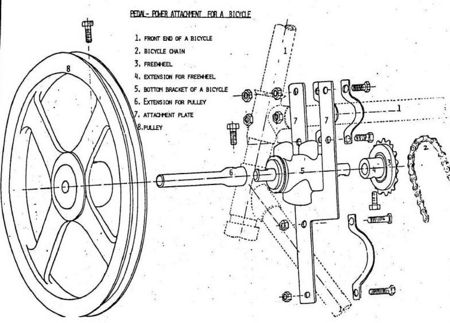
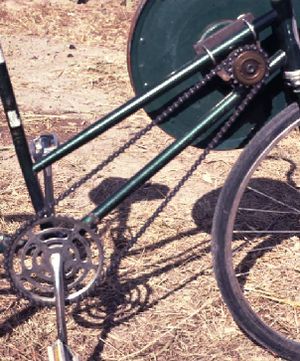
Stand assembly[edit | edit source]
The stand described here is designed to support most bicycles. Modifications may have to be made for some bicycles.
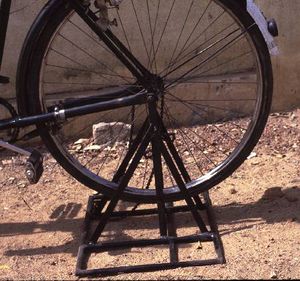
Materials[edit | edit source]
- 12 ft. (3.7m)‑‑3/4" (20mm) angle, 1/8" (3.2mm) wall thickness
- 8ft. (2.5m)‑‑1/2" (12.5mm) x 3/16" (4.7mm) flatsteel.
- 1 - 1" (25mm) x 6" (15.25cm) cold‑rolled steel rod for axle extensions.
- 16‑‑1/4" (7mm) x 5/8" (16mm) bolts, nuts, lockwashers
- 2 ‑‑3/8" (10mm) x 3/4 " (20mm) bolts, washers
- 2 - extra rear axle nuts which fit the bike to be adapted.
- The stand assembly is divided into two parts: the rectangular base frame and two triangular upright supports. (See Figure 7). Measure and cut the five pieces of 3/4" (20mm) angle specified for the base frame. Mitre the corners at 45 degrees so they fit together tightly and form square corners.
- Weld the rectangle together. Do not weld the center frame member to the rectangle yet.
- Measure and cut as specified the 5 pieces for each upright support.
- Carefully assemble the upright support pieces for welding, being sure to leave a 1/8" (3.2mm) gap in the base of each support. (See Figure 7). This gap will mate with the center frame member of the base frame, allowing the upright supports to slide to accommodate different rear axle widths. Note that the two upright supports are not identical. They are mirror reflections of one another. Also note the orientation of the various pieces of angle, how they fit together etc. See drawings and photos of stand. (FIGURES 7 & 8)
- Weld each upright support assembly together into a secure structure.
- Place the upright supports onto the base frame, and position the center frame member so that it mates with the gap in the side supports. Mark its position, and weld it in place.
Base frame[edit | edit source]
Plan view of frame in support position. All pieces 3/4" (19mm) steel angle.
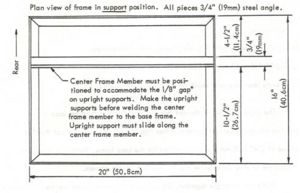
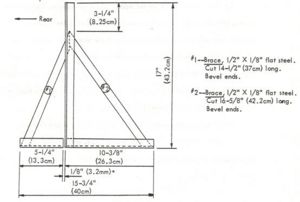
Upright supports[edit | edit source]
Make two pieces of upright supports: one as shown and another one a reflection of the one shown below. All pieces are made of 3/4" (19mm) steel angle, unless specified otherwise. Weld all joints.
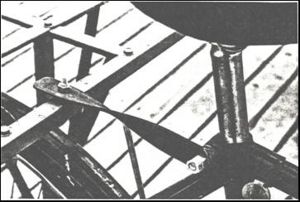
Luggage Rack Latching Device[edit | edit source]
Fashion a device to hook the stand to the bike frame below the seat when the stand is in the luggage rack position. A piece of 3/4' (20mm) x 6" (15cm) flat steel can be twisted and spring‑mounted as shown in figure 10. A pin fastened to the end locks into a hole in the stand. The stand is now completed.
Recommendations for operation[edit | edit source]
- Farm implements or small machines can be driven at speeds up to 800 RPM using a bicycle adapted for pedal‑power. High speeds (500 ‑ 800 RPM) can be achieved by using a V‑belt drive with an 8" (20cm) pulley on the bike and a 2" (50mm) pulley on the machine to be driven. V‑belts do not require the precise alignment that roller‑chains do, but must be properly tensioned in order to deliver adequate torque without slipping.
- For speeds less than 500 RPM, and especially for very high torque applications such as grinding, roller‑chain drives are recommended. Speeds in excess of 800 RPM can be achieved by using larger diameter pulleys.
- V‑belts or roller chains must be adequately tensioned, otherwise chains will derail, and belts will slip.
- To maintain proper alignment of the bicycle with the machine to be driven, it is recommended that both of them be anchored securely to the ground, or to a platform. This is especially important for high torque applications. The stand assembly can be staked into the ground with stakes made from bent steel reinforcing bar.
- Flywheels are often helpful because they store energy. For grinding grains use of flywheel is recommended.
- During short periods that require high power, the varying loads encountered in threshing, grinding and sawing, can be smoothed out with a flywheel of proper mass and dimension. A flywheel suitable for most pedal power applications is constructed from a discarded automobile flywheel mounted to a 3/4" (20mm) shaft, and suspended on flange mounted ball bearings Whenever possible, mass could be added or built into the rotating parts of implements to achieve a flywheel effect.
- Our tests show that maintaining a constant pedalling speed of between 50 and 60 RPM is very important for efficient use of human muscle power. Consequently, it is important on load or the feed rate be sympathetic to the speed of the person pedalling. Overloading should be avoided, as it breaks the pedalling rhythm, and usually results in an inferior and less uniform job.
- The seat on the bicycle should be adjusted to permit full extension of the legs during pedaling.
- It is important to choose pulleys and sprockets that are sized to create drive ratios which enable the operator to maintain the desired pedalling speed (usually about 50‑60 RPM). One accomplishes this by first insuring that the machine to be driven does not demand too much of an average operator. Generally, pedal‑power devices are intended to operate machines requiring 1/3 horsepower (250 watts) or less. Second, one determines the desired RPM of the machine to be driven, and calculates the pulley sizes accordingly.
Various applications[edit | edit source]
-
Rice Threshing
-
Winnowing
-
Corn Shelling
-
Water Pumping from a Shallow Well
-
Operating a Circular Saw
-
Operating a Wood Working Lathe
-
Peanut Shelling

